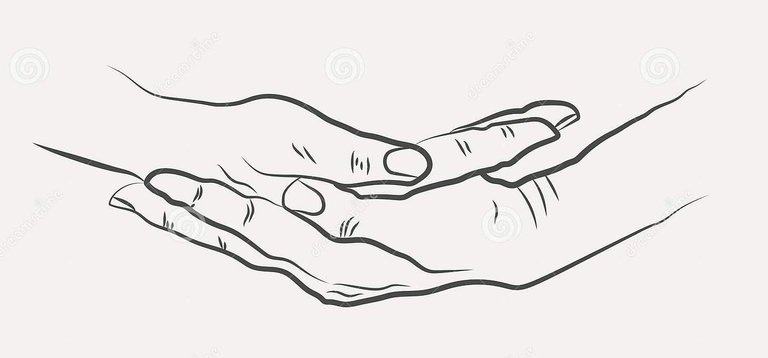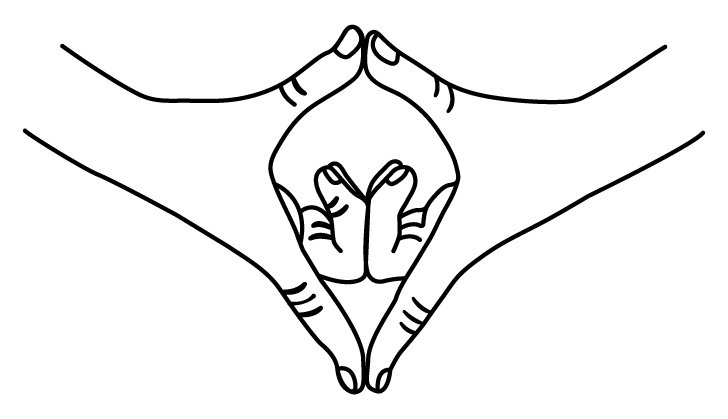Como bien expliqué en el post anterior https://www.ecency.com/hive-120078/@katherinevc/mudras-i-esp-eng-what, mudra significa gesto, actitud, expresión y son el canal por cual expresamos nuestra energía. Ahora bien, la práctica de mudra puede involucrar todo el cuerpo, no solo consiste en una simple posición de las manos, también se realiza en combinación con una técnica de asana, pranayamas, bhanda y técnicas de visualización.
Continuando con los mudras de las manos, presento los siguientes:
Bhairava Mudra:
Las dos manos representan los nadis, ida y pingala y la unión del individuo con la conciencia suprema, donde la conciencia individual se unifica en la mente y el cuerpo, tanto el Yo interno como el externo son uno. Este mudra se utiliza en prana mudra, también se puede utilizar durante la práctica de pranayama y de meditación.
¿Cómo realizarla?
- Adopte una postura de meditación cómoda con la cabeza y la columna recta.
- Ponga la mano derecha sobre la mano izquierda con las palmas hacia arriba.
- Apoye ambas manos sobre el regazo.
- Cierre los ojos, relaje todo el cuerpo y mantenga la inmovilidad.
- Cuando la mano izquierda se coloca sobre la derecha, la práctica se denomina bhairavi mudra. Bhairavi es la contraparte femenina de Bhairava.
Este mudra sabe llevar la armonía, mantiene el equilibrio entre su parte izquierda y derecha de su cerebro. Hacer este ejercicio aporta estabilidad y una especie de mediación para todo su cuerpo y ser interior, desarrollando la concentración y la relajación física interna. Las personas que sufren de ansiedad y cambios de humor regulares deben hacer esto, creo es muy útil cuando hay estrés.
As I well explained in the previous post https://www.ecency.com/hive-120078/@katherinevc/mudras-i-esp-eng-what, mudra means gesture, attitude, expression and they are the channel through which to express our energy. Now, mudra practice can involve the whole body, not only does it consist of a simple hand position, it is also performed in combination with an asana technique, pranayamas, bhanda and visualization techniques.
Continuing with the mudras of the hands, I present the following:
Bhairava Mudra:
The two hands represent the nadis, ida and pingala and the union of the individual with the supreme consciousness, where the individual consciousness is unified in the mind and body, both the inner and the outer self are one. This mudra is used in prana mudra, it can also be used during pranayama and meditation practice.
How to do it?
- Get into a comfortable meditation posture with your head and spine straight.
- Put your right hand on top of your left hand with your palms facing up.
- Rest both hands on your lap.
- Close your eyes, relax your whole body, and stay still.
- When the left hand is placed over the right, the practice is called bhairavi mudra. Bhairavi is the female counterpart of Bhairava.
This mudra knows how to bring harmony, it maintains the balance between the left and right part of your brain. Doing this exercise provides stability and a kind of mediation for your whole body and interior, developing concentration and internal physical relaxation. People who suffer from anxiety and regular mood swings should do this, I think it is very helpful when there is stress.
Yoni Mudra:
Este mudra invoca la energía primaria inherente a la matriz o fuente de la creación. La forma en que se entrelazan los dedos, crea un cruce de conexión de energía de la mano derecha a la izquierda y viceversa. Este circuito equilibra las energía del cuerpo y ayuda a equilibrar las actividades de los hemisferios derecho e izquierdo del cerebro. el hecho de juntar las puntas de los dedos índices y pulgares intensifica el flujo de prana.¿Cómo realizarla?
- Adopte una postura de meditación cómoda con la cabeza y columna recta.
- Primero une la yema de tu dedo índice derecho con la del izquierdo, y luego la yema de tu pulgar derecho con el izquierdo.Acerque los pulgares al cuerpo para adoptar la forma de la base de un yoni o matriz.
- Dobla el resto de dedos de ambas manos haciendo que se entrelazan entre ellos, o que simplemente se toquen. Lo importante es formar un triángulo con los dedos pulgar e índice.
- A continuación, lleva tus manos un par de dedos debajo de tu ombligo, es decir en el lugar del segundo chakra o chakra sexual.
- También se puede practicar entrelazando los dedos meñiques, anulares y del corazón sin girarlos hacia adentro. Los pulgares se pueden cruzar frente a los dedos índices estirados, o se pueden estirar con las yemas juntas hacia el cuerpo.
- Los codos tienden a apuntar hacia afuera de manera natural, lo cual ayuda a abrir el área del pecho.
Yoni Mudra:
This mudra invokes the primary energy inherent in the matrix or source of creation. The way the fingers intertwine creates an energy connection that crosses from the right hand to the left and vice versa. This circuit balances the energies of the body and helps to balance the activities of the left and right hemispheres of the brain. bringing the tips of the thumb and index finger together intensifies the flow of prana.How to do it?
- Get into a comfortable meditation posture with your head and spine upright.
- First join the pad of your right index finger with your left, and then the pad of your right thumb with your left. Bring your thumbs close to the body to take the shape of the base of a yoni or womb.
- Bend the rest of the fingers of both hands so that they interlock with each other or just touch. The important thing is to form a triangle with your thumb and index finger.
- Then bring your hands a few fingers below the navel, that is, in the place of the second chakra or sex chakra.
- It can also be practiced interlocking the little, ring, and middle fingers without turning them inward. The thumbs can be crossed in front of the extended index fingers or they can be stretched with the fingertips together towards the body.
- The elbows tend to point outward naturally, which helps to open up the chest area.
When you do, you will notice an energy flowing through your belly or pelvic floor. Hold the yoni mudra for 5 or 10 minutes breathing relaxed, then rest and in the next sessions you can increase the minutes.
In the case of pregnant women, do not do it for a long time, since the yoni mudra activates the descending energy of your body, and specifically, of that area.

